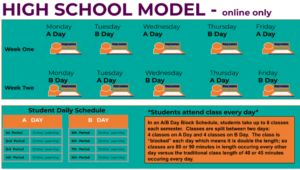Helping Chief Academic Officers Make The Shift From Managed Instruction To Personalized Learning

We’ve updated this post with some newer, more useful and up-to-date information. Check out Helping CAOs Make the Shift to Personalized Learning!
There are thousands of chief academic officers (CAOs) that just figured out how to build and manage instruction regimes. Now they’re trying to pivot to blended learning and they’re getting a lot of pressure from their boss and teachers to consider updates.
As noted a year ago, it’s easy to say that managed instruction is old school and digital learning is the future. But this debate is worth unpacking. The lack of alignment of instruction and assessment, as well as schedule, structure, and support services is a huge problem in education. It leads to poor student performance and frustration on the part of educators.
Charter management organizations (CMO) brought a built-from-scratch ‘no-excuses’ alignment but did so around the old model of a centralized standards-based curriculum, with a traditional age-cohort school model. Many of these CMOs serve relatively homogeneous low-income communities where all the kids are behind. Talented teachers, common pacing, and a rigorous focus on execution resulted in pretty good outcomes.
School districts saw this improvement and began implementing similar ‘managed instruction’ (or ‘aligned instructional system’) schemes yielding some improvement. Even with marginal execution, these programs ensure that students are receiving grade level instruction (whether or not they are on grade level) which can improve results on standardized grade level assessments.
But now it’s possible to create personalized blended learning environments where adaptive diagnostics pinpoint challenges and gaps and where student progress is based on demonstrated mastery. Here’s a quick summary of managed instruction versus next generation learning.
| Managed Instruction | Next-Gen | |
| Design | Centralized | Bottom up, top down, inside out |
| Materials | Print on seven year cycle | Dynamic modular digital library |
| Pacing | Uniform | Individualized |
| Assessment | Periodic benchmark | Continuous & adaptive |
| Progress | Cohort | Demonstrated mastery |
| Competencies | Instructional design, pedagogy | Learner experience, EdTech, data |
| Desired Outcomes | Math & reading test scores | Communications, critical thinking, habits of success |
This change reflects a dramatic change in the mental model of senior district officials in terms of how they understand systems, what they look for in classrooms, and how they organize roles and goals of staff members.
In particular, the competency-based lead at The Learning Accelerator, John Branam, said, “Next generation CAOs must be comfortable with software and data.” This transformation includes replacing core processes like textbook adoption with cloud-based platform management strategies. “The CAO must also be the chief change management architect,” said Branam.
Many professions, like doctors, go through shifts in technology and mediated treatment that results in significant shifts in practice. But this is more like a train conductor becoming an air traffic controller. To complicate things, we don’t really have this new model fully baked yet, so it takes a small leap of faith and a lot of iterating.
A midwestern EdLeader said, “We have identified a need to educate the mid-level managers between the principals and the superintendent.” Known as ‘Executive Director of Academics and Director of Curriculum and Instruction’ these positions are responsible for improving and maintaining high marks on the state report card. “They seem to be the keepers and protectors of current practices,” he said.
We identified this national talent development problem conducting the Smart Cities investigation. In the last week, I’ve discussed it with leaders coast to coast. Following are 10 elements of comprehensive solutions to the challenge of helping chief academic officers reframe their work.
Build, don’t break. Brian Greenberg, Silicon Schools, suggested building CAOs a bridge from managed instruction to personalized and blended learning. That’s good advice since all of the teachers in a managed instruction system will need to make the same trip.
Both systems share goals for high quality learning every day in every classroom. Both systems value reliability and productivity. CAO interest in differentiated learning may be just the hook, according to Greenberg.
It would be very difficult to flip a big system from managed instruction to personalized learning, so (as suggested in the Blended Learning Implementation Guide) a phased approach beginning where there is the most leadership makes sense. Work can start at schools, levels, and subjects most ready to make the shift.
Community conversations. The direction that the superintendent and board sets is obviously important both in terms of vision and organization. This direction should be a product of community conversations. As Tony Wagner has been advocating for 20 years, conversations should cover three important questions about, “What’s different?” “What should young people know and be able to do?” and, as a result, “What kinds of learning experiences do they deserve?”
In El Paso, community conversations resulted in a vision of Active Learning: challenging, personalized and engaging work with strong supports. The CAO is well versed in managed instruction but appreciates the need for a change of course in a district damaged by a decade of thin test prep. Key was hiring a curriculum director with a background in gifted and talented with a well developed picture of active learning and a commitment to all children.
Trips. “The roadshow is what gets them,” said Brian Greenberg, Silicon Schools. Field trips have been life changing for me and, like Brian, I can’t think of a better way to begin building a new mental model than seeing powerful learning experiences. (See 100 schools worth visiting and 25 districtsworth visiting.)
Conference. Mike Cowan in Mesa, AZ hosted an EdTech Conference and invited a select group of vendors. On a release day teachers visited the conference. Teams of teachers were invited to submit applications for mini-grants.
Teacher-leaders. CAOs should identify and listen to their best teachers. Given the flood of inexpensive devices, free apps, and open resources, good teachers are doing more to supplement a core curriculum with flipped lessons and blended classrooms.
There are several good examples of cities identifying and cultivating teacher leadership. Fulton County Georgia schools have identified four teachers in every school. These “Vanguard Teachers” meet regularly, provide real-time professional development to other teachers, and support the development of school-based blended learning plans. The CityBridge Fellowship in Washington D.C. is another good example, especially when combined with regional NGLC new and transformed school grants.
Tiered support. A system of earned autonomy and tiered support focuses district resources where they’re most needed and gives high performing schools autonomy to design innovative learning experiences. A tiered accountability system would allow a phased shift to personalized learning by allowing top performing schools to select a blended model and by identifying a partner for the lowest performing schools.
Adaptive. Shifting from periodic benchmark assessments (designed to assess a one speed, one size fits all curriculum) with adaptive assessments (e.g. i-Ready from Curriculum Associates orMAPS from NWEA) provides better information and can be combined with individually targeted instruction that make up an important part of a blended learning program.
School grants. A somewhat subversive approach for turning a CAO around are new or transformed school grants. Carnegie’s Opportunity by Design is supporting new school development in Cleveland, Denver, New York, Philadelphia, and Providence. NGLC supported about 45 next-gen models nationwide before launching regional school grant programs in Chicago, Denver, New Orleans, Oakland and Washington (read the story of 14 teams).
Blended Learning Directors. One problem that CAOs face is that even if they want to make the pivot, they can’t find knowledgeable and experienced staff to lead the effort. Beth Rabbitt said The Learning Accelerator is trying to build a new pipeline of these folks that need to bring a combination of teaching, technology, and project management skills to the table.
Networks. Regional blended professional learning networks (PLN) of CAOs seem like an obvious solution. Some intermediate units (i.e., counties, BOCES, RSD, ESD) already host these job-alike networks, but not all of them focus on the shift to next-gen learning. These PLNs could make valuable links to state legislatures on topics including assessment, teacher evaluation, and infrastructure (see guide for superintendents).
For more check out:







0 Comments
Leave a Comment
Your email address will not be published. All fields are required.